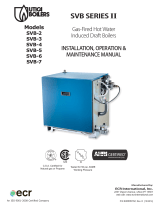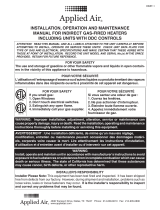
9
the PV terminal and the common terminal "PV/MV" wire
has continuity to the module, the gas valve may be
defective. If no voltage is present at "PV" on the ignition
control, the control may be defective.
Main burner
ignition
Pilot ignites,
"proves", and main
gas valve opens
with main burners
lighting.
YES↓ NO→
- If pilot flame is present, but main burners do not light (no
main burner gas), check to make sure green ground wire
from module to control box ground lug has continuity.
This can be verified by disconnecting the wire and
measuring the resistance through both ends of the wire
with an ohmmeter. The reading should be "0" ohms.
- Check to make sure pilot flame covers the electrode or
flame sensing rod. Check the electrode or flame sensing
wire for continuity. Replace wire if cracked.
- Check for cracked ceramic electrode insulator. Clean
electrode or flame sensing rod if carbon is present.
- Make sure vertical pilot draft shield is installed. Pilot
flame should be steady without wavering or blowing.
- Check for voltage between the "MV" terminal of the
ignition module and the ground lug. If no voltage is
present, and above conditions (ground, pilot flame, flame
sensor, wire leads) are O.K., replace ignition control.
- Check for voltage between MV and MV/PV of the gas
valve. If voltage is present, but valve does not open,
replace gas valve.
Main burners
operate until
thermostat is
satisfied.
Blower and
burners stop.
Main burners
(continued)
Main burners and
blower operate until
thermostat is
satisfied
YES - Checks O.K.
NO→
- If blower continues to operate, but main burners cycle
erratically, check for proper grounding of the ignition
control and continuity of the pilot electrode wire. Make
sure the pilot draft shield is in place. The pilot adjustment
screw should be adjusted to the full open position
(counterclockwise). Make sure the pilot electrode is clean
and not damaged or bent. The flame sensing current
output from the pilot can be measured by connecting a
microamp meter from the pilot flame sense lead to the
"sense" terminal on the ignition control. Replace the pilot
if the electrode or wires have deteriorated or if the flame
sense current is below 1.0 microamps. Replace ignition
control if problem persists and above checks proved
satisfactory.
- If the blower continues to operate, but the burners cycle
off, check the ECO (lower) terminals of the thermostat. If
the ECO (high limit) trips, the ignition will "lock out"
requiring resetting. Normally, the thermostat should open
before the high limit trips. If the high limit opens before
the thermostat, replace the control.
- Another possible cause for the burner to cycle is the
pressure switch contacts are opening. Make sure the
pressure switch tubing fittings are snug, but do not use
tools to tighten the plastic nut on the pressure switch
connection. Check to make sure the flue collector lid
under the jacket top is tightly secured. The gasket under
the lid must be intact. The gasket under the blower
mounting flange must be secure and the joint between the
blower mounting flange and blower transition duct must
be caulked with high temperature sealant (Dow RTV or
equivalent). The vacuum at the pressure switch may be
checked with a tee installed at the pressure switch tubing
with a draft gauge or manometer connected. Cold
starting vacuum should be close to -2.0" w.c. (-.49 kPa),
with a hot running operation vacuum near -1.75" w.c. (-.44
kPa). The pressure switch contacts should close by -1.45"
Internet Version for Reference Only












